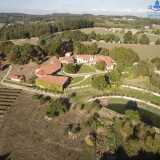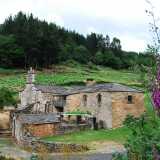Eastern Miño Itinerary
This route will take you to some of Ribeira Sacra’s most essential attractions, such as the Monastery of San Salvador de Ferreira in Pantón, the impressive Augacaída Waterfall, and the town of Portomarín, which was relocated to higher ground when the Belesar dam was built.
We recommend getting started at about 9.00 a.m., so you will be able to complete the full itinerary without having to rush. Also, some of the locations have specific visiting hours, such as the Convent of San Salvador de Ferreira and the Arxeriz Ethnographic Museum.
On this route you will start the day in the municipality of Pantón, by visiting the Augacaída Waterfall, one of the highest in Galicia. To reach this waterfall you will have to follow a short hiking trail. It will take you through a leafy forest until reaching the waterfall, and it also leads to Castro de Marce, which is an impressive natural viewpoint overlooking the Miño River. The easiest way to get to the start of this route is to take the N-120 in the direction of Ourense, and then turn off at the junction for Guítara.
After this breath of fresh air, the next stop on this route is the Convent of San Salvador de Ferreira in Pantón, also known as the Convent of Las Bernardas. This is currently the only place in Ribeira Sacra where the monastic life remains active.
After your visit (and of course after sampling some of the magnificent sweets they sell...), your next stop will be the Arxeriz Ethnographic Museum (also known as the Arxeriz Ecomuseum). You will get there by following the LU-P-4102 highway, which connects Pantón with O Saviñao.
The Arxeriz Ecomuseum is a fantastic exhibition space located in a historic manor house, with a focus on the culture of water and the ethnography of Ribeira Sacra. There is also an excavated Castro culture site on the museum grounds, in a location that also offers excellent views of the river’s iconic meander known as Cabo do Mundo.
When your visit there is finished, you can continue to the next stop: the Church of Santo Estevo de Ribas de Miño, which is one of the Romanesque jewels of Ribeira Sacra. You have two options for getting there:
- The shorter option: first travel towards Escairón (on the same highway you were on before taking the junction to the Ecomuseum), and when you get to the centre of that town, follow the signs to the Church of Santo Estevo.
- The longer option (an additional 15-20 minutes by car, not including any stops you make): this option lets you travel directly along the shore of the Miño River, and on the way you can stop at places like the riverside beach at A Cova, the Church of San Martiño de A Cova, and the village of Belesar. For this option, follow the signs from the Ecomuseum indicating A Cova beach (“Praia de A Cova”). When you arrive at that beach, continue along the same highway until reaching Belesar, and then continue until reaching the larger motorway that goes in the direction of Monforte de Lemos. Take that motorway until you see signs indicating Santo Estevo de Ribas de Miño.
Once you have finished your visit to Santo Estevo de Ribas de Miño, return to the motorway and travel to Escairón. There, take the LU-P-4102 to Paradela, then from there, travel to the Church of San Facundo de Ribas de Miño on LU-P-4202. This church, which is located at a spectacular site overlooking the Miño River, entirely surrounded by vineyards, was declared as a National Monument in 1982.
After this visit, return to Paradela and take the LU-633 to Portomarín. This is a town with a remarkable history, and it is where your itinerary for the day will end. Historically associated with the Way of St James (Camino de Santiago), Portomarín is still an iconic stopping point along the French Route. The new Portomarín was created in the 1960s, when the historic town became submerged by the river when the Belesar dam was built. Here you can find some real treasures of Romanesque architecture, such as the Church of San Xoán (also known as the Church of San Nicolás), which was moved to stone-by-stone from its original location.
Formed by the Aguianza stream, this 40-metre high waterfall is very close to its mouth in the Miño river.

The only female monastery that keeps religious life in Ribeira Sacra. Almonst known by Monastery of Bernardas

The museum is located in a 17th-century pazo, or manor house, on an estate measuring 35 hectares. The buildings house a number of exhibition rooms.
The first sources which are known about this former monastery refer to an inventory of the bishopric of Lugo of the 12th century, being a donation by Mrs Urraca Fernández.

The whole monument of San Facundo de Ribas de Miño receives first prize of the Association of Architects of Galicia as best restoration project carried out in the autonomous community in 1998.
Portomarín is one of the towns that are part of the Ribeira Sacra in the province of Lugo. There are about 1650 inhabitants. The village was born by the banks of the river Miño and had two neighbourhoods, San Juan and San Pedro.
In 1963, when the dam of Belesar was built, the old Portomarín was flooded by the waters of the river Miño. The village was rebuilt on a hillock, having the new layout and some medieval taste with cobbled streets and houses with arcades. For this reason, the Romanesque church of San Juan and that of San Pedro, as well as other buildings of importance, were moved to the new site stone by stone.
 What would you improve?
What would you improve?